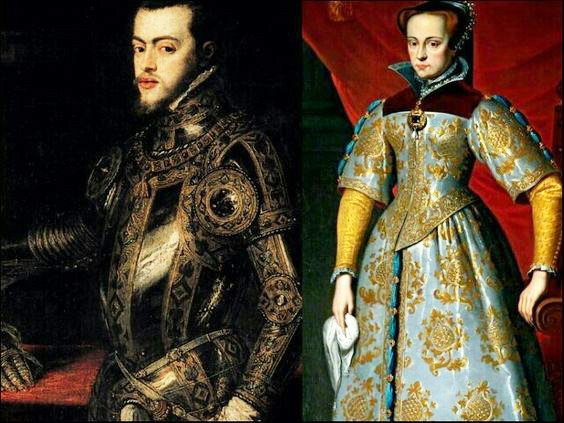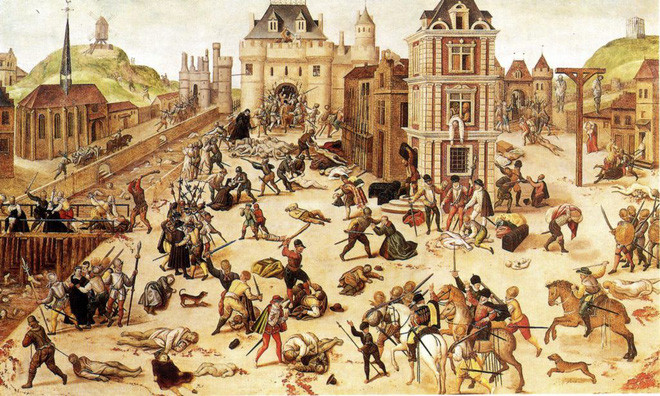The three most notorious tyrants of the Middle Ages night
The Middle Ages was one of the darkest and most savage times in European history, and this was also the time when the most cruel monarchs appeared.
1. Queen Mary I - Britain's "blood queen"
The 16th century was Britain's most difficult period under the reign of Queen Mary I, a fierce believer in Jacob. The daughter of King Henry VIII - the king of brutality and brutality, famous for beheading his wife, Mary even surpassed her father in such cruelty that the people gave her the nickname "Bloody Mary" or "Blood queen".

Portrait of Queen Mary I (right) with her husband - King Philip II of Spain.
When Edward's younger brother died, Mary recruited soldiers to depose and execute Queen Jane Gray. After becoming the Queen, she ordered brutal persecution and executed many Protestant people to force them to follow Catholicism.
One of the scariest crimes of Queen Mary I in British history is to order 300 people to burn alive on a red fire amid the screams of the people.
During her time in power, she was really immersed in the pastime of cremating the opponents. Even Church dignitaries such as Archbishop Cranmer, Nicolas Ridley, Hugh Latiner . all shared the same fate, being ordered by Mary I to close the wooden pillar between the square and burn alive because they grew up. the sound of her opposing actions.

During the reign of the "bloody Mary", Protestants were forced to choose between conversion or massacre.
After marrying King Philip II - a famous tyrant of Spain, Mary I like a fish that meets water, learns many new ways of killing.
However, at the end of her life, she lived silently, alone in despair and regret at a few relatives visiting castles and often heard the complaints and curses of the people talking about her. According to many accounts, before I died, Mary I even got mad and writhed and moaned: "Oh! Blood, blood! Blood is full of people!".
The "terrible Ivan" emperor, also known as the Tsar Ivan Vasilyevich, was a notorious brutal king. After his wife died, Tsar Ivan became out of control and gradually became a cold-blooded murderer.

Ivan "tyrant" is one of the most famous Tsar of the Russian history.
Ivan "tyrant" had set up a secret army called the Oprichniki to sweep and destroy the possible revolts that the Tsar wanted to extinguish "from the infancy". And the name of the cruel Tsar is tied to the massacre of 60,000 people in Novgorod.
Not only that, Tsar Ivan Vasilyevich was still mercilessly murdering his son when his daughter-in-law dressed in revealing. In particular, the Tsar struck a daughter-in-law, causing her to miscarry. When witnessing that scene, Tsar Ivan's son stood to protect his wife, but was angry and killed by his father. A few years later, he also died of heart disease.

The name of the cruel Tsar is closely linked to the massacre of 60,000 people in Novgorod.
3. Count Vlad Tepes III - vampire legend alive
The famous novel "Dracula" written in 1897 by writer Bram Stoker has the main character of Count Dracula - a vampire who draws human blood with extremely cruel and brutal actions.
Few people know that many episodes in the famous novel "Dracula" are purely based on a true character in history, namely Vlad Tepes III - who is seen as a demon.
Born in Romania in 1431, Vlad Tepes III is the son of warlord Vlad II Basarab - a hero of Romania, who led the Romanian army against the invasion of Turkish troops for many years.
Because of the glorious victories, the Roman emperor gave Vlad II Basarab the title Dracul meaning "son of a dragon". Therefore, after Vlad Tepes III came to power, the people in the area often called him Dracula, meaning Dracula's son.

The character of Count Dracula is a true character in history.
Some history books in Romania record that the daily life of Prince Vlad Tepes III is indispensable to killing.
He was addicted to murder, saw it as a pastime and only smiled the most when he saw the victim die slowly in extreme pain.
One of the most gruesome punishments that Vlad still preferred was to stow the ground and throw people over. In addition, Dracula has hundreds of other horrible and cruel ways of doing things.
Once, a merchant in a neighboring country came to Dracula's castle to hear someone rummaging through the carriage and losing his 160 gold coins.
Dracula comforted the unfortunate man, reassuring to find the thief. Immediately, Dracula ordered the soldiers to enter the merchant's wagon 161 gold coins.
The morning after returning, the merchant counted the money and discovered an excess of one. He returned to tell Dracula that he had received the money, but he had more than one dollar. Dracula's answer made the merchant fearless:
Dracula deliberately did so and if the merchant did not announce the excess money, he himself would be obliged.
Another story recounts that two envoys visited Dracula. When meeting Dracula, the two envoys refused to remove their hats and explained that they violated their customs.
Dracula immediately nailed the hat to the heads of the two envoys to never violate their tradition.

Count Dracula is addicted to murder, consider it a pastime.
It was the Dracula's brutality that caused the fall of his power. Final,
Finally, Count Dracula was deposed and pursued. He escaped from the castle through a secret passage, leaving his beloved wife behind. Too frustrated and frightened, Dracula's poor wife planted herself from the high floor.
After escaping, Dracula went to help the Hungarian king, but was imprisoned for 12 years. In 1476, the Hungarian king entrusted Dracula to the Turkish army, he was executed and buried at Snagov monastery.
After the death of the tyrant, the horror stories about him continued to be handed down and inspired the writer Bram Stoker to create a fascinating classic novel "Dracula".
- The truth of mythical myths about the Middle Ages
- The misconception of the Middle Ages makes you laugh!
- 5 silly predictions about the Middle Ages Day
- The rich in the Middle Ages suffered from lead poisoning due to their preference for ceramics
- Nero is not a tyrant?
- Eyes round with 6 ridiculous bans on ridiculous Middle Ages
- You: Discover new treasure from the Anglo-Saxon era
- 16 grisly torture methods of the Middle Ages
- Detecting longevity oak from the Middle Ages
- Scary healing ways in the Middle Ages
- The 'unsanitary' habits of the Middle Ages made you cry
- Use 3D technology to read books from the Middle Ages
 'Fine laughs' - Scary and painful torture in ancient times
'Fine laughs' - Scary and painful torture in ancient times The sequence of numbers 142857 of the Egyptian pyramids is known as the strangest number in the world - Why?
The sequence of numbers 142857 of the Egyptian pyramids is known as the strangest number in the world - Why? History of the iron
History of the iron What is alum?
What is alum? This is the largest creature that has ever flown on Earth.
This is the largest creature that has ever flown on Earth.  The mystery of bloodthirsty vampires through the ages
The mystery of bloodthirsty vampires through the ages  The ant species has a function
The ant species has a function  New discovery about the tomb of Dracula
New discovery about the tomb of Dracula 